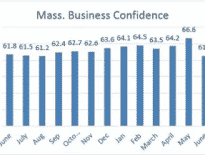Community banks and credit unions have always taken pride in their relationships with local businesses, which is why they have had so much success in the small to medium business loan market. But they better keep an eye on their rear-view mirror because larger banks are starting to encroach.
While large banks ($10 billion assets or more) are still approving fewer small business loan applications than credit unions and smaller banks, they approved nearly three out of every 10 small business loan applications in May, according to the Biz2Credit Small Business Lending Index.
That represents a post-recession high point for large banks and the trend is expected to continue, say experts.
“The biggest driver of small banks’ growth is that the bigger banks have been distracted and focused on different things. They have been required to hold more capital and been subject to more stringent stress testing,” Jared Shaw, managing director and senior analyst at Wells Fargo Securities, told Banker & Tradesman. “Big banks are now in a strong position and less likely to let customers leave. Those most dissatisfied with bigger banks have already left. All of this is going to make growth harder for smaller banks.”
Large banks have in recent years begun to show increasing interest in business sectors in which smaller financial institutions usually thrive.
For instance, Santander in late 2016 hired Seth Goodall, former regional administrator for U.S. Small Business Administration New England, to lead the bank’s SBA division as it looks to bulk up SBA lending.
Goodall previously told Banker & Tradesman he expects Santander to grow its loan book in the $100,000 to $5 million range.
Wells Fargo and JPMorgan in June announced they would offer mobile accounts with no overdraft fees – a revenue source for the industry that brings in $15 billion annually – stealing an offering that credit unions regularly boast.

Bram Berkowitz
Overcoming Ambivalence
While it is true that small banks have always thrived in the SMB market, it is also true that large banks have largely ignored this market, said David O’Connell, a senior analyst on the Boston-based Aite Group’s wholesale banking team.
“It’s not that they walked away from the [SMB] market after the financial crisis in 2008. They have always been ambivalent in the market. Bankers are good at underwriting big loans to big companies,” he said. “It’s easier to make money lending at scale in the large loan market than the small loan market.”
The reason for this, said O’Connell, is because the underwriting process is essentially the same for small and large business loans. Banks need to do the same due diligence for both, which includes determining a company’s cash flow, liquidity and collateral, among other factors, he said.
But the rising rate environment has changed the way big banks value small businesses, said Joe Fielding, a partner in the financial services division of Boston-based Bain & Co.
On the deposit side, according to Fielding, most banks did not try and compete on price when rates were low and there was ample deposit liquidity. But as interest rates rose, it has become clear the war for deposits that was evident in the years leading up to the financial crisis has returned, he said.
“Banks are now experiencing customer and deposit attrition in both consumer and small business segments,” said Fielding. “If any banks have ignored small businesses, they are certainly paying attention now because you can’t afford to ignore this critical segment.”
Digital Alternatives
The emergence of alternative lenders such as LendingClub has made the SMB market hard to ignore.
More than 20 percent of SMBs surveyed in 2016 said they would probably consider seeking credit in the next three years from an alternative lender, according to a report from Aite that fielded responses from over 500 SMBs that had applied for a loan in the past two years. Thirty-eight percent of respondents said they might consider it.
“Alternative lenders showed up with more marketing savvy and a better digital service,” said O’Connell. “They brought in lots of customization, digitalization and big data to the SMB market, so they could serve up a digitalized experience and do decision-making at scale.”
These concepts and the success alternative lenders had at gaining market share made larger banks take a hard look at the SMB market.
Large banks can provide the digital experience and even offer SMBs more of a human interaction than alternative lenders, which O’Connell said is something that this segment seeks out.
Fielding and O’Connell agree that smaller financial institutions still hold more knowledge of customers and more relationships in the SMB market than larger banks. Nevertheless, as more SMBs demand digital experiences, larger banks will be able to further even the playing field.
“The lure of local convenience for small businesses is diminishing as they become more cashless and seek the same digital ease that consumers value,” said Fielding. “Bigger banks can afford to invest more in these capabilities, and therefore will create a tug of war over who will win the small and medium business customer.”




 |
| 


